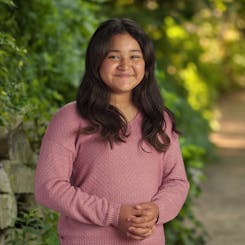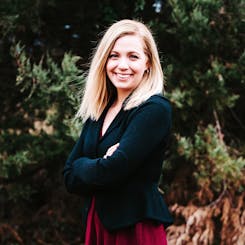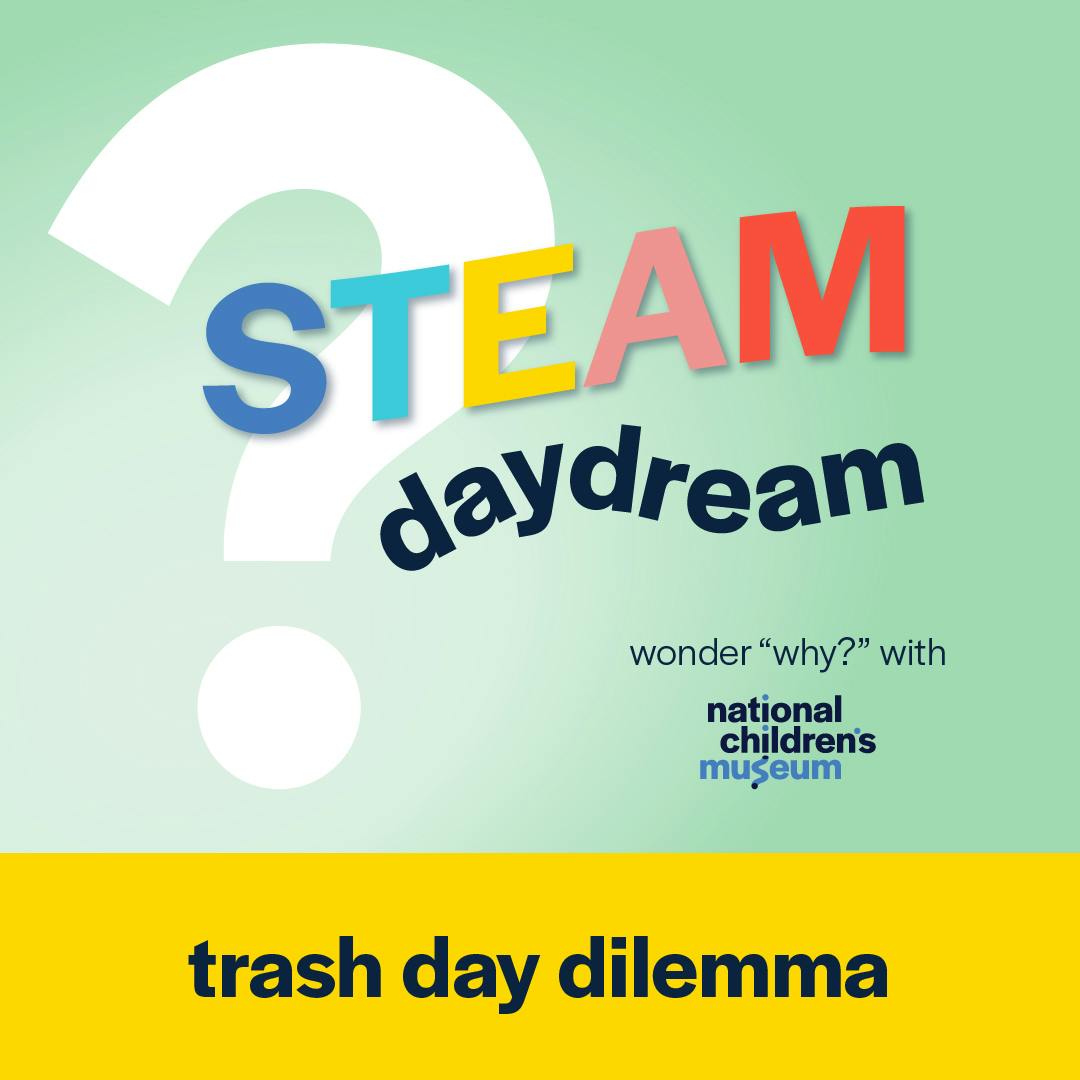trash day dilemma
Aubrey and Andre organize a surprise birthday party for A.J. complete with extravagant decorations and a humongous cake, but it turns out they got the day confused. 11-year-old Kid Investigator Evelyn wonders where all the decorations will end up once they’re thrown away. The STEAM Daydream team goes on a wild trash chase to find out. Suit up, this investigation might get a little stinky!
 meet our kid investigator Evelyn C. (she/her) from Vienna, Virginia 11-years-old favorite school subject: social studies |
 meet our expert Dr. Rachelle Riegerix, Ph.D. (she/her) Scientist at the U.S. Environmental Protection Agency fun fact: "Preventing food from going to landfills is one of the easiest and most powerful things you can do to fight climate change." |
- atmosphere: the layer of gases surrounding a planet
- climate change: the long-term changes in the the Earth’s overall weather patterns, such as high and low temperatures and humidity
- compost: a way to break down organic waste, like leftover food scraps or shredded wood, into useable material like fertilizer for foil
- greenhouse gases: gases in Earth's atmosphere that trap heat by letting sunlight pass through the atmosphere but preventing the heat from leaving the atmosphere
- greenhouse effect: the way gases trap heat close to Earth’s surface making it warmer, like a blanket wrapped around our planet
- methane: a colorless, odorless gas that appears in nature and is produced from human and natural activity; classified as a greenhouse gas
- 5-LS2-1 Ecosystems: Interactions, Energy, and Dynamics: Develop a model to describe the movement of matter among plants, animals, decomposers, and the environment.
- 5-PS1-2 Matter and Its Interactions: Measure and graph quantities to provide evidence that regardless of the type of change that occurs when heating, cooling, or mixing substances, the total weight of matter is conserved.
- 5-PS1-4 Matter and Its Interactions: Conduct an investigation to determine whether the mixing of two or more substances results in new substances.
AUBREY: 9,998… 9,999… 10,000!
ANDRE: Hello?
AUBREY: Andre! You’re here!
ANDRE: Wow, did you do all this yourself, Aubrey?
AUBREY: Sure did. With creative direction from Newton, of course.
[BARK/MEOW]
AUBREY: What do ya think?
ANDRE: That’s a lot of balloons.
AUBREY: 10,000 to be exact! A.J. is going to be blown away. Did you pick up the cake?
ANDRE: Sure did! All ten tiers of it! Who did you invite?
AUBREY: Well, there’s you and me, and Newton… Maggie the Mailperson is around here somewhere.
MAGGIE: Over here! Just finishing up the streamers.
AUBREY: Looks great, Maggie! Okay, A.J. should be here any minute. Let’s get to our places people!
[BARK/MEOW]
AUBREY: Sorry, Newton—people and barking cat.
ANDRE: Hit the lights! Get ready to cue the music! I think I hear him coming!
A.J.: So this is the STEAM Daydream studio. Let me give you a quick tour and introduce you to the team before we start investigating.
ANDRE, AUBREY, MAGGIE: Surprise!
[MUSIC]
ANDRE: Happy birthday, A.J.!
A.J.: What?
MAGGIE: He said happy birthday!
A.J.: Happy birthday? To who? Me? It’s not my birthday!
AUBREY: Oops—I must have written that down wrong.
MAGGIE: Who’s that behind you, A.J.? Maybe it’s their birthday!
A.J.: Oh, this is Evelyn, our 11-year-old Kid Investigator from Vienna, Virginia.
EVELYN: Hi everyone, it’s nice to meet you! Unfortunately, today’s not my birthday either.
ANDRE: Aw, rats!
AUBREY: Wait, did you say Kid Investigator?! Does that mean what I think it means?
[MUSIC]
A.J.: You’re listening to Season 2 of STEAM Daydream with National Children’s Museum, where we solve the world’s many STEAM mysteries one episode at a time: we’ll observe, we’ll ask questions, we’ll investigate, we’ll research, and then we’ll connect the dots! I’m A.J., and our Kid Investigator Evelyn was just about to brief the team on today’s mystery. Take it away, Evelyn!
EVELYN: Thanks, A.J.! These decorations look awesome by the way.
AUBREY: Why, thank you!
EVELYN: But what were you guys planning on doing with them once the party was over?
AUBREY: Well, I was thinking about keeping them up for… I don’t know… forever?
A.J.: Forever? There’s barely enough room to move in here.
ANDRE: He has a point, Aubrey.
AUBREY: Ok, can we at least keep the streamers, and maybe—10 balloons?
A.J.: Sure.
EVELYN: Ok, so what will happen with all the other balloons and the leftover cake?
ANDRE: We’ll throw it away.
EVELYN: Okay, and then what?
AUBREY: What do you mean? We’ll just put everything in the trash can over there.
EVELYN: I mean, what happens to the balloons and cake after you put them in the trash can?
ANDRE: Well, once a week a garbage truck comes around and collects all the trash and takes it…somewhere.
EVELYN: Bingo!… THAT’S the mystery we’re solving today: Where does trash go?
ANDRE: Well, there’s only one way to find out: a fact-finding mission! Everyone suit up—this investigation might get a little stinky.
MAGGIE: I’m dressed for a party, not a fact-finding mission. Sorry!
A.J.: And I think I’ll stay here and eat this birthday cake. It’s not going to eat itself!
ANDRE: Evelyn, Aubrey, are you in?
EVELYN: Whatever it takes to solve this mystery!
AUBREY: Let’s not waste another moment!
ANDRE: Follow me!
[MUSIC]
EVELYN: So what’s the plan?
ANDRE: You’re looking at it!
EVELYN: And how is that orange dumpster a part of the plan?
ANDRE: Well, if we want to figure out where the trash goes, we need to follow it!
AUBREY: I’ll go get the roller blades!
ANDRE: No need, Aubrey. It’s Wednesday morning. And you know what happens on Wednesday mornings? The garbage truck comes around to collect the trash. Hurry up and climb in! Here comes our ride!
AUBREY: Everybody hang on!
AUBREY, ANDRE, EVELYN: Woah! Oof! Ack!
EVELYN: Is everyone ok?
ANDRE: Better than ok! Look at this cool hat I found! Why would anyone want to throw this away?
AUBREY: My thinking cap! A.J. said he lost it last week. How did it end up in the dumpster?
EVELYN: Man, it smells like feet in here.
ANDRE: Yeah, you landed by a pile of shoes.
AUBREY: There’s just so much trash. Tissues—gross!—an old dog toy, used paper plates, bubble wrap. Where’d it all come from?
EVELYN: Well, let’s start with what we know... How much waste do you think you create in a day?
AUBREY: I don’t know, but I’m going to guess a lot.
EVELYN: Try 5 pounds. That’s the average amount of waste created by every person who lives in the United States every day!
ANDRE: 5 pounds?! That’s how much my bunny weighs!
AUBREY: If a person produces an average of 5 pounds of trash each day and there’s 365 days in a year, that means each person creates about one thousand eight-hundred pounds of trash in a year. That’s like how much a full grown hippopotamus weighs.
ANDRE: Roughly 330 million people live in the United States. Imagine the weight of 330 million hippos..but in trash! That adds up fast!
EVELYN: Now, some of that waste, like plastic containers and aluminum cans, are recycled, which means it turns into a material to make new things. And some of it is composted, like food scraps that break down and eventually turn into soil. But a lot of that waste can’t be recycled or composted. It’s just trash.
AUBREY: But if there’s that much trash in the world, wouldn’t we see it everywhere? Wouldn’t there be huge piles of trash around every corner?
ANDRE: Yeah, where does it all go?
EVELYN: Well, I have a feeling we’re about to find out. I think the garbage truck is slowing down.
ANDRE: Hold on! Here we go again!
AUBREY, ANDRE, EVELYN: Woah! Oof! Ack!
EVELYN: Where are we?
AUBREY: It’s like a sea of trash.
ANDRE: That sign over there says “transfer station”... whatever that means.
AUBREY: Well, it looks like we solved the mystery in record time! Trash goes to the transfer station. Okay, now let’s head back to the studio and celebrate with some cake!
EVELYN: Not so fast, Aubrey. I don’t think this is where the trash ends up.
AUBREY: What do you mean? Of course it is–we followed it here ourselves!
EVELYN: If this is where the trash ends up, then why are they loading it onto those other trucks?
AUBREY: Hm, good question.
EVELYN: I know that transfer means to move from one place to another, so maybe this is just a pitstop for the trash.
AUBREY: Look over there! Maybe the person in the very official looking hard hat can help.
[MUSIC]
AUBREY: Hey, my name’s Aubrey, and this is Andre and Evelyn. We’re the STEAM Daydream investigative team from National Children’s Museum, and we’re on a fact-finding mission to figure out where trash goes.
ANDRE: I love your hard hat! Who are you?
RACHELLE: Thanks! This is my lucky green hard hat. I’m Dr. Rachelle Riegerix with the United States Environmental Protection Agency.
AUBREY: Well, do you know what a transfer station is?
RACHELLE: So a waste transfer station is between when trash is collected at your home, or recycling, and it’s taken to this waste transfer station. The end goal of a waste transfer system is to make sure we’re keeping as much trash out of the landfill and recovering as much as possible. The waste would be sorted into four different categories: You’d have hazardous waste, which would be your chemicals, or your household cleaning products. Then you have your recyclable materials, then you have specific special recycled materials like batteries. They’re going to a battery recycling facility. And then you have your trash that will go into a landfill that’s not hazardous and not recyclable. Actually, I was just about to head over to the landfill, do you want to tag along?
AUBREY: That would be awesome!
RACHELLE: Great! Here, you’ll need to wear these.
ANDRE: Hey! Our own green hard hats!
[MUSIC]
RACHELLE: Here we are! The landfill…
ANDRE: Wow, look at all this trash.
AUBREY: Woah, trash as far as the eye can see!
EVELYN: What happens now?
RACHELLE: So when the trash gets to the landfill, the trucks will go to these specific sites, which are called “cells.” And so, think of a really big hole in the ground. There’s the layer of earth, and then there’s a layer of sand, and then there’s a liner, and then there’s another layer of sand, and then the trash sits on top of that. And when that hole is completely filled, they will cap it, which is the liner will go on top of it. And then there’s another layer of sand, another layer of clay, and a layer of earth.
[MUSIC]
RACHELLE: So if you were a piece of trash inside of this cell that has this cap on top of it, you are going to decompose, and depending on what type of material that you are depends on how long it will take for you to decompose. So, if you’re a piece of food, in a normal compost—say you’re composting at home—you might decompose pretty quickly, in a matter of weeks or months. But if you’re in a landfill, you need to decompose a lot longer. But, what’s happening while you’re decomposing is that you’re letting off these greenhouse gasses. What they do is they trap heat in our Earth’s atmosphere, which causes the Earth to warm, which ultimately will cause climate change. The biggest ones that we see are your Nitrous Oxide, your Carbon Dioxide, and your Methane. And, it will also produce possible liquids too. It could be anything from cleaning products, food, all of it combined together is just a really yucky mess.
[MUSIC]
RACHELLE: The United States has a limited amount of space, which means that we have a limited area to put trash. So that means that we need to make sure that we are trying to keep as much trash out of a landfill that we possibly can. That means making sure that we compost our food waste, or that we recycle as much as we can, and that we reduce the amount of trash that we’re actually using in our homes.
AUBREY: That’s a great tip, I should start recycling more at home.
RACHELLE: Well, I should get back to work, good luck with your mystery!
ANDRE: Thanks for your help!
EVELYN: We should probably head back to the studio, too. I’m sure A.J. is wondering where we are.
[MUSIC]
AUBREY: A.J., we’re back!
A.J.: Ugh…
ANDRE: A.J.?
A.J.: Ugh… What?
EVELYN: Are you ok?
A.J.: Too much cake. Where have you guys been? And why are you wearing hard hats? And what’s that smell?!
ANDRE: We followed the trash.
AUBREY: That’s right. And guess what I found! My thinking cap! I rescued it from the dumpster!
EVELYN: You wouldn’t know anything about how it got there, would you A.J.?
A.J.: Hm, strange. I have no idea how it ended up in the trash.
AUBREY: Well, now that I have it back, I think it’s time we connect... the... dots.
ANDRE: Aubrey, you put your thinking cap on top of your hard hat?
AUBREY: Safety first!
[MUSIC]
EVELYN: All right. When we decide something is no longer serving its purpose, we throw it away and it disappears.
ANDRE: But it doesn’t magically vanish from our planet. Instead, it sets off on an epic journey, starting with a thrill ride on a garbage truck!
EVELYN: Once the garbage truck collects the trash, it travels to the nearest waste management facility.
AUBREY: In some places, the garbage truck takes the trash to a transfer station, where it gets sorted into categories: recyclable materials, compostable materials, hazardous materials, and then all other solid waste.
ANDRE: Each category of materials is then taken to its final destination by truck, train, or even boat!
EVELYN: A lot of the time, the solid waste that’s not recyclable, compostable, or hazardous, eventually makes its way to a landfill, where it’s finally buried in giant holes in the ground called cells.
ANDRE: The team that works at the landfill takes extra care to protect the surrounding land and water from the trash buried in the cells.
EVELYN: Finally, we learned that as the buried trash decomposes, it releases dangerous greenhouse gasses, including methane and carbon dioxide.
ANDRE: Greenhouse gasses are bad for our planet and contribute to global warming because they trap heat in our atmosphere which warms the Earth.
AUBREY: To stop the greenhouse gasses from entering the atmosphere, most landfills have a bunch of pipes built into the cells that suck up the methane and carbon dioxide from the decomposing trash. The harmful gasses are then burned or turned into energy.
ANDRE: All of these things are in place to help reduce the negative impacts that trash has on the planet, but there are many steps we can take to reduce the issue way before our trash lands in a landfill.
A.J.: Like what?
EVELYN: Well, we can throw away less stuff so fewer things end up in landfills.
ANDRE: Exactly! The 4 R’s are a good place to start: reduce, reuse, recycle, and refuse.
AUBREY: We can reduce the amount of trash we make, reuse items in new ways, recycle items to make new things, and refuse items that we don’t need.
EVELYN: That’s right! Less trash means fewer greenhouse gasses released into the air, which means a happier planet!
[MUSIC]
AUBREY: You know, we probably don’t need 10,000 balloons for A.J.’s next birthday party. I’ll make decorations out of recycled materials instead!
EVELYN: Good idea, Aubrey! And I think I have an idea to reuse the balloons we already have.
AUBREY, ANDRE: Water balloon fight!
[MUSIC]
A.J.: Well, there you have it, Dreamers! Another STEAM mystery solved. Are you looking for ways to reuse materials at home? Stop by the Tinkerers Studio at National Children’s Museum for inspiration, where activities are designed to use recycled materials in new and exciting ways. And don’t miss our physical Climate Action Heroes flow-quiz, where you can discover new ways to help protect the planet using climate action superpowers. Before we go, let’s hear what visitors at National Children’s Museum had to say about trash.
CHILD 1: Hi, my name’s Arna. Trash is basically stinky. Sometimes you can just see it flying away. Trash smells like all kinds of things—food, poop—all kinds of different things.
CHILD 2: My name is Luna, I am seven years old. Trash smells like icky stuff.
CHILD 3: Trash smells like really terrible, not like dog poop, but—something like that.
CHILD 4: Some things go in the trash, and some things get recycled.
CHILD 5: I recycle stuff like plastic, paper, metal.
CHILD 6: My name is Tegan. You can’t litter trash. You gotta pick it up and throw it in the trash can.
[MUSIC]
A.J.: Now that’s some serious trash talk! Well, that’s all for today’s episode! Don’t miss our next investigation all about sound. It’ll be music to your ears. In the meantime, if you enjoyed today’s show, please leave a review to help other curious kids discover our podcast. Be sure to subscribe wherever you’re listening so you don’t miss our next adventure. You can find more STEAM programs and resources on our website: www.nationalchildrensmuseum.org. Season 2 of STEAM Daydream with National Children’s Museum is generously sponsored by GEICO. It’s narrated by me, A.J. Calbert, produced by Paige Childs, with sound design and engineering by Maddie Zampanti of Conceptual Podcasting.

